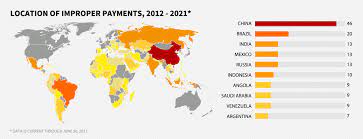A Deep Dive into WPP’s Bribery Schemes in India, China, Brazil and Peru (Part II of III)

The SEC’s FCPA settlement with WPP for over $19.2 million provides a variety of bribery schemes in several high-risk venues. The schemes are instructive because they remind anti-corruption compliance professionals of the number of ways in which bribery can be carried out. In this way, the SEC’s enforcement action is informative and contains helpful reminders on various risks in the anti-corruption arena.
India: In July 2011, WPP obtained a majority interest in an agency located in Hyderabad, India. The co-founder CEO (A) was appointed to lead the subsidiary. Half of the India subsidiary’s revenue derived from the Indian States of Telangana and Andhra Pradesh’s Departments of Information and Public Relations (“DIPR”), which were responsible for retaining media agencies to conduct advertising and public relations campaigns for their respective state governments.
Starting in 2015 and continuing to September 2017, WPP received seven anonymous complaints alleging two specific bribery schemes involving the DIPR. The first involved the use of a third-party agency (“Vendor A”) used to purchase media for DIPR and the creation of an off-the-books slush fund. The second involved a fabricated advertising campaign in order to create a second off-the-books fund at a third-party agency (“Vendor B”) to compensate DIPR officials for awarding contracts to the Indian subsidiary and the personal benefit of CEO A.
Vendor A Bribery Scheme: As detailed by the SEC, the Vendor A bribery scheme worked as follows: (1) DIPR awarded India Subsidiary a contract under which India Subsidiary created an advertisement and then purchased space in newspapers to display the advertisement; (2) DIPR paid a set publicly-available fee to media agencies for purchasing advertisement space (the “card rate”); (3) CEO A was able to negotiate rates with the newspapers that were significantly less than DIPR’s card rate; (4) to utilize the difference between DIPR’s card rate and the actual price paid to the newspapers for bribes to DIPR officials, India Subsidiary entered into the agreement with Vendor A to purchase the advertising space on DIPR’s behalf; and (5) after paying the newspapers and taking its cut of the scheme, Vendor A facilitated payments to DIPR officials. This same mechanism was used to make payments to CEO A.
After receiving an initial complaint in July 2015 identifying the ongoing bribery, WPP directed its India Financial Director (“India FD”) to investigate the allegations. The India FD hired an international accounting firm. The accounting firm, however, relied on information provided by CEO A and India Subsidiary CFO (“CFO A”), did not communicate with any third parties and provided a report that did not address the bribery allegations. The accounting firm’s report only noted certain red flags regarding Vendor A.

In the spring of 2016, WPP received three additional anonymous complaints related to the Vendor A bribery scheme. The India FD retained the same accounting firm and requested the firm to conduct a transactional review of India Subsidiary’s business with Vendor A. As part of the review, Vendor A was asked to produce documentation of relevant invoices. Vendor A refused to do so. The India CFO terminated the relationship (but allowed the subsidiary to pay outstanding amounts due).
Vendor B: The second bribery scheme involved Indian subsidiary paying DIPR officials through an intermediary. In this scheme, DIPR paid India Subsidiary $1.5 million to allegedly execute a media campaign to celebrate the formation of the Indian state of Telangana in June 2015. In reality, no such campaign occurred. Instead, CFO A requested that Vendor B falsify documents to reflect that Vendor B provided services for the campaign to justify paying money to Vendor B, which in turn paid over $1 million to a third-party intermediary responsible for making payments to DIPR officials. With the remaining funds, Vendor B made cash payments to CEO 1 and India Subsidiary to pay overdue receivables from unrelated clients.
In 2017, WPP received additional anonymous complains about the bribery schemes. WPP directed a member of its legal team to conduct an investigation which included review of various email accounts stored on servers in the US. The legal investigation identified email communication dating back to 2015, that confirmed the bribery payments. Ultimately, CEO A admitted that he was aware that third parties made payments to government officials on behalf of India Subsidiary, and WPP terminated both CEO A and CFO A. As a result of the bribery schemes at India subsidiary, WPP was unjustly enriched by $5,669,596.
China: In 2014, WPP obtained a majority interest in an agency headquartered in Shanghai, China, which focused on celebrity branding and endorsement. WPP appointed that the local co-founder could serve as the CEO (CEO B). In November 2018, China Subsidiary was able to avoid paying $3,2 million in taxes to a Chinese tax authority by making payments to a vendor identified by tax officials and providing $2,000 worth of gifts and entertainment to tax officials during the same time period. China Subsidiary paid approximately $107,000 to the tax official’s chosen vendor in the two months before a tax audit finalized. The vendor kept a small percentage of the money and transmitted the rest to an unknown recipient. Although China Subsidiary’s books and records reflected that the vendor performed services for a client, a China Subsidiary employee falsified documentation to justify the transaction.

Despite the presence of red flags that, if properly investigated, could have led to the prevention or detection of China Subsidiary’s improper payments, WPP did not uncover the scheme until early 2019 while conducting an unrelated review.
In 2017 and 2018, WPP was aware of significant red flags related to China Subsidiary and CEO B surrounding its tax audit and improper use of a vendor. WPP received an email complaint outlining serious concerns but took no action. In June 2018, WPP overlooked another warning sign stemming from CEO B’s inconsistent explanation of the resolution of the tax audit.
Later, WPP uncovered an off-the-books account maintained by China Subsidiary reflecting the payments to the vendor recommended by the tax officials. As a result, CEO B finally resigned in April 2019 – a year and a half after WPP first became aware of the significant issues at China Subsidiary.
Brazil: In 2016, WPP obtained a majority interest in a public relations agency in São Paulo, Brazil. WPP agreed that Brazil Subsidiary’s minority owner would serve as the CEO of Brazil Subsidiary (“CEO C”). WPP had an adviser payment policy that prohibited its companies from paying third parties to assist in obtaining or retaining government contracts without WPP’s approval. Despite the policy, Brazil Subsidiary made improper payments to vendors in connection with securing government contracts at CEO C’s direction. These payments directly violated WPP’s adviser payment policies and were made in circumstances in which there was a high probability that a portion of the payments may have been passed to the government officials with the authority to award the contracts. To disguise the fact that Brazil Subsidiary’s payments to the vendors related to obtaining or retaining government contracts, Brazil Subsidiary falsified its books and records to reflect that the vendors performed bona fide services, such as marketing or IT services.
Peru: In 1996, WPP obtained a majority interest in a creative services agency headquartered in Lima, Peru. WPP agreed that Peru Subsidiary’s founder and CEO would remain as CEO of the company post-acquisition (“CEO D”) and retain a 30% stake in the company. WPP terminated CEO D in 2018 for participating in a scheme to pay illegal bribes and manipulate Peru Subsidiary’s earnings.

The bribery scheme involved a construction company funding the mayor of Lima’s political campaigns in exchange for contract awards. At CEO D’s urging, Peru Subsidiary agreed to be a conduit for the construction company’s bribe to the mayor of Lima. Also, CEO D disguised the corrupt source of the funds used for the mayor of Lima’s political campaign by funneling the construction company’s payments to Peru Subsidiary through WPP subsidiaries in Colombia and Chile. Consequently, the WPP subsidiaries in Colombia and Chile falsely recorded that they received money in return for services performed for the construction company, and Peru Subsidiary maintained no records indicating that the construction company paid for a portion of the mayor of Lima’s political campaigns. WPP did not uncover Peru Subsidiary’s role in the bribery scheme until a criminal proceeding highlighted the conduct in 2019.
















2 Responses
[…] going forward. WPP-Brazil made improper payments to vendors in connection to obtain government. As Mike Volkov has noted, “These payments were made in circumstances in which there was a high probability that […]
[…] A WPP-Brasil fez pagamentos incorretos aos vendedores em relação à aquisição do governo. Como Mike Volkoff Nota, “Esses pagamentos foram feitos em circunstâncias nas quais havia uma grande […]